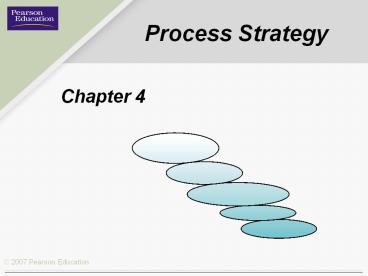Process Strategy - PowerPoint PPT Presentation
1 / 20
Title:
Process Strategy
Description:
Chapter 4 How Process Strategy fits the Operations Management Philosophy Process Strategy Process strategy is the pattern of decisions made in managing processes so ... – PowerPoint PPT presentation
Number of Views:169
Avg rating:3.0/5.0
Title: Process Strategy
1
Process Strategy
Chapter 4
2
How Process Strategy fits the Operations
Management Philosophy
Operations As a Competitive Weapon Operations
Strategy Project Management
Process Strategy Process Analysis Process
Performance and Quality Constraint
Management Process Layout Lean Systems
Supply Chain Strategy Location Inventory
Management Forecasting Sales and Operations
Planning Resource Planning Scheduling
3
Process Strategy
- Process strategy is the pattern of decisions made
in managing processes so that they will achieve
their competitive priorities. - A process involves the use of an organizations
resources to provide something of value. - Major process decisions include
- Process Structure
- Customer Involvement
- Resource Flexibility
- Capital Intensity
4
Major Decisions for Effective Process Design
5
Process Structures in Services
- A good process strategy for a service process
depends first and foremost on the type and amount
of customer contact. - Customer contact is the extent to which the
customer is present, is actively involved, and
receives personal attention during the process.
6
Customer-Contact Matrix for Service Processes
Less Customer Contact and Customization Service
Package
7
Product-Process Matrix for Processes
8
Production and Inventory Strategies
- Make-to-order strategy A strategy used by
manufactures that make products to customer
specifications in low volume. - Assemble-to-order strategy A strategy for
producing a wide variety of products from
relatively few assemblies and components after
the customer orders are received. - Make-to-stock strategy A strategy that involves
holding items in stock for immediate delivery,
thereby minimizing customer delivery times. - Mass production A term sometimes used in the
popular press for a line process that uses the
make-to-stock strategy.
9
The Big Picture King Soopers Bakery
10
Links of Competitive Priorities with
Manufacturing Strategy
11
Customer InvolvementGood or Bad?
- Improved Competitive Capabilities More customer
involvement can mean better quality, faster
delivery, greater flexibility, and even lower
cost. - Customers can come face-to-face with the service
providers, where they can ask questions, make
special requests on the spot and provide
additional information. - Self-service is the choice of many retailers.
- However customer involvement can be disruptive
and make the process less efficient. - Greater interpersonal skills are required.
- Quality measurement becomes more difficult.
- Emerging Technologies Companies can now engage
in an active dialogue with customers and make
them partners in creating value.
12
Resource Flexibility
- Flexible workforce A workforce whose members are
capable of doing many tasks, either at their own
workstations or as they move from one workstation
to another. - Worker flexibility can be one of the best ways to
achieve reliable customer service and alleviate
capacity bottlenecks. - This comes at a cost, requiring greater skills
and thus more training and education. - Flexible equipment Low volumes mean that process
designers should select flexible, general-purpose
equipment.
13
Relationship between Process Costs and Product
Volume
14
Application 4.1
Fm Fb cb cm
10,000 400,000 20 50
13,000 frames
Q
15
Capital Intensity
- Capital Intensity is the mix of equipment and
human skills in the process the greater the
relative cost of equipment, the greater is the
capital intensity. - Automation is a system, process, or piece of
equipment that is self-acting and
self-regulating. - Fixed automation is a manufacturing process that
produces one type of part or product in a fixed
sequence of simple operations. - Flexible (or programmable) automation is a
manufacturing process that can be changed easily
to handle various products.
16
Economies of Scope
- In certain types of manufacturing, such as
machining and assembly, programmable automation
breaks the inverse relationship between resource
flexibility and capital intensity. - Economies of scope are economies that reflect the
ability to produce multiple products more cheaply
in combination than separately. - With economies of scope, the often conflicting
competitive priorities of customization and low
price become more compatible. - Taking advantage of economies of scope requires
that a family of parts or products have enough
collective volume to fully utilize equipment.
17
Decision Patterns for Service Processes
Major process decisions
18
Decision Patterns for Manufacturing Processes
Major process decisions
19
Focus by Process Segment
- A facilitys process often can neither be
characterized nor actually designed for one set
of competitive priorities and one process choice. - At a services facility, some parts of the process
might seem like a front office and other parts
like a back office. - Plants within plants (PWPs) are different
operations within a facility with individualized
competitive priorities, processes, and workforces
under the same roof. - Focused factories are the result of a firms
splitting large plants that produce all the
companys products into several specialized
smaller plants.
20
Strategies for Change
- Process Reengineering is a fundamental rethinking
and radical redesign of processes to improve
performance dramatically in terms of cost,
quality, service, and speed. - Process improvement is the systematic study of
the activities and flows of each process to
improve it.































